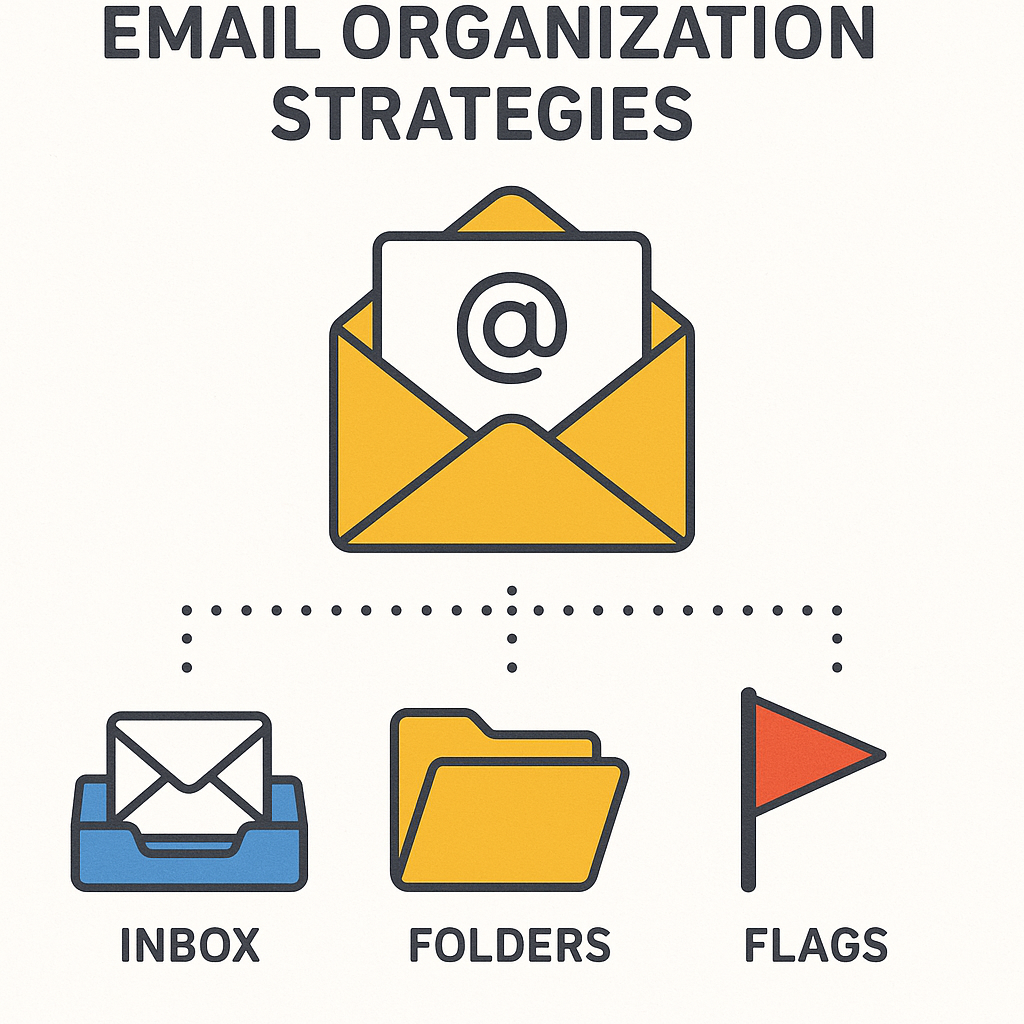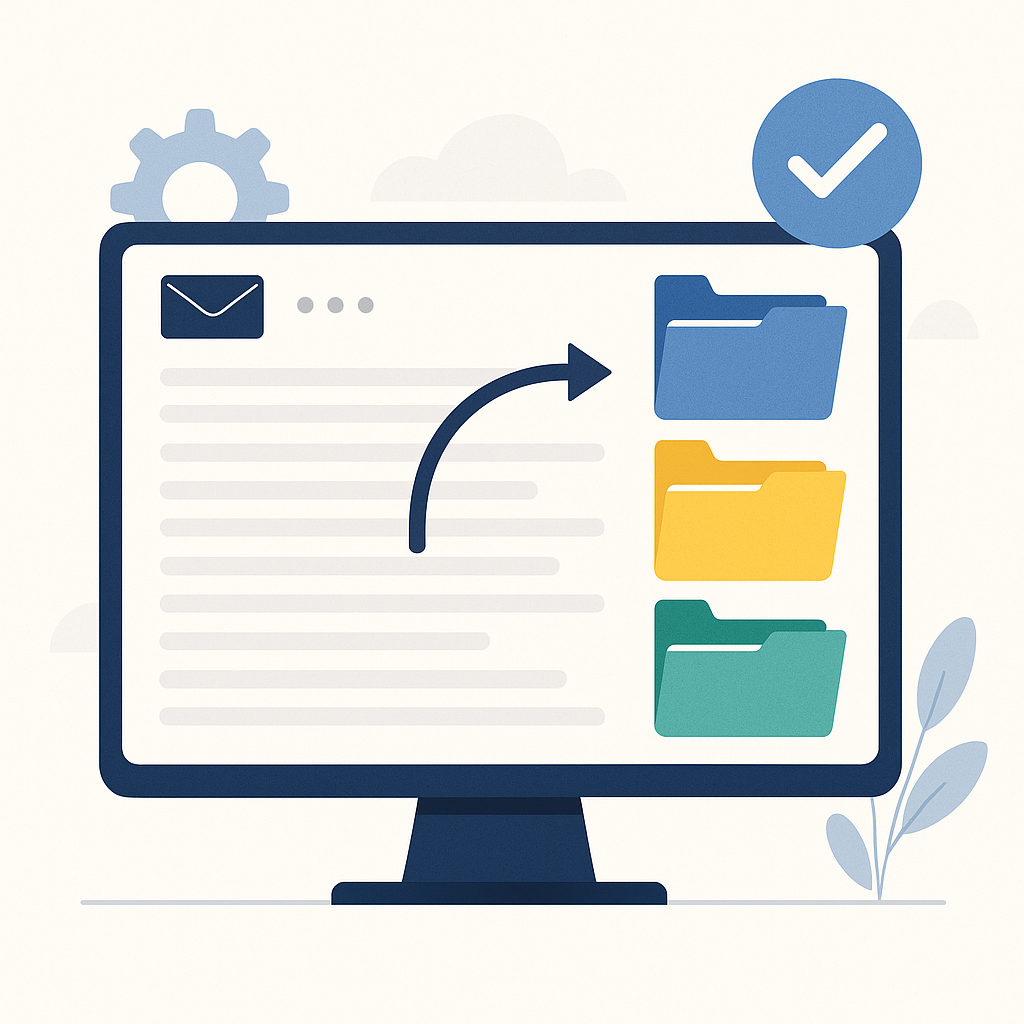Top Email Organization Strategies for Boosted Productivity & Focus

Are you drowning in a relentless tide of emails? For busy business executives, entrepreneurs, sales professionals, and remote workers, the inbox often feels less like a communication tool and more like a never-ending to-do list, a black hole for focus and productivity. This constant deluge of messages can lead to overwhelm, missed deadlines, and a profound sense of digital fatigue. If your current inbox management strategy involves letting emails pile up until you can no longer ignore them, you're not alone. But there's a better way.
The good news is that reclaiming control over your email doesn't require superhuman effort, just smart email organization strategies. This comprehensive guide will equip you with actionable email productivity tips, from foundational decluttering techniques to advanced prioritization frameworks, and the transformative power of ai executive assistant tools. By mastering these strategies, you'll not only cut through the clutter but also free up valuable time, reduce stress, and significantly boost your overall executive email efficiency, allowing you to focus on what truly matters.
Foundational Email Organization Strategies: Decluttering Your Digital Workspace
Before diving into advanced techniques, it's crucial to establish a clean and functional foundation. Think of it as a comprehensive digital decluttering of your email environment. A streamlined inbox is the first step towards effective email organization strategies.
Unsubscribe Ruthlessly from Unwanted Newsletters
One of the quickest ways to reduce email volume is to stop receiving messages you don't read or need. How many newsletters, promotional offers, or notifications do you receive daily that simply add to the noise? Take a few minutes each day or week to review your subscriptions.
- Identify the culprits: Look for emails that consistently go unread or offer no value.
- Click 'Unsubscribe': Most legitimate marketing emails have an unsubscribe link at the bottom. Use it without hesitation.
- Use a tool: If you have hundreds of subscriptions, consider a service that helps you quickly unsubscribe from multiple lists at once.
Statistic: Studies show that the average professional receives over 120 emails per day, a significant portion of which are often newsletters or promotional content. Reducing this influx is paramount for effective email organization strategies.
Delete or Archive Old Emails Strategically
Holding onto every email "just in case" can quickly lead to a bloated inbox that's hard to navigate. Develop a system for clearing out old messages.
- Delete: Permanently remove emails that have no future value (e.g., old notifications, spam that slipped through, completed tasks).
- Archive: For emails you might need to reference later but don't require immediate action, archive them. This moves them out of your inbox but keeps them searchable. Many email clients offer generous storage, so archiving is a low-stakes way to keep your main inbox tidy.
- Address Gmail storage full issues: Regularly clearing out large attachments or unnecessary emails can prevent storage problems and ensure smooth operation.
Implement a Robust Folder and Label System
Folders and labels are your best friends for categorizing emails and making them easily retrievable. The key is to create a system that makes sense to you and that you'll consistently use.
- Project-based: Create folders for ongoing projects, clients, or initiatives.
- Action-based: Use labels like "To Do," "Waiting On," "Read Later," or "Reference."
- Automate where possible: Set up rules to automatically sort incoming emails into specific folders or apply labels based on sender, subject, or keywords. This significantly streamlines your inbox management.
Embrace the "Zero Inbox" Concept (as a Goal)
Inbox Zero isn't about having literally zero emails in your inbox at all times; it's a philosophy about processing each email as it arrives or during dedicated processing times, so your inbox acts as a temporary holding area, not a permanent storage locker. The goal is to touch each email once and decide its fate.
Set Aside Specific Time Blocks for Email Management
Constant email checking is a major productivity killer. Instead of reacting to every notification, schedule specific times for processing emails. This is a core time management email strategy.
- Morning check: A quick scan to identify urgent items.
- Mid-day processing: Respond to non-urgent emails, delegate, or defer.
- End-of-day wrap-up: Clear out the inbox, prepare for the next day.
Expert Tip: "Setting aside specific time blocks for email management helps minimize distractions and improve focus on other tasks. To implement this strategy, allocate chunks of time during the day for checking and responding to emails." - Ultramail.ai
Smart Triage & Prioritization: The Art of Deciding What Matters Now
Once your inbox is decluttered, the next step in email organization strategies is to develop a system for quickly assessing and acting on incoming messages. This is where effective inbox management truly shines.
The "4 D's" of Email Processing
This simple framework helps you make quick decisions about every email:
- Delete: If it's spam, irrelevant, or already handled, delete it immediately.
- Do: If it takes less than two minutes to respond or complete the action, do it now. This is a cornerstone of efficient email productivity tips.
- Delegate: If someone else is better suited to handle it, forward the email and assign the task.
- Defer: If it requires more time or thought, move it to a "To Do" folder or add it to your task list for later action.
Leverage the Eisenhower Matrix for Email Prioritization
Apply the "Urgent/Important" matrix to your emails:
- Urgent & Important (Do First): These are critical emails requiring immediate action.
- Important but Not Urgent (Schedule): Emails that are crucial for your goals but don't need an immediate response. Schedule time to address them.
- Urgent but Not Important (Delegate): Emails that demand quick attention but could be handled by someone else.
- Neither Urgent nor Important (Delete): These are usually distractions or irrelevant messages.
Batch Similar Tasks and Responses
Instead of responding to emails one by one as they come in, group similar tasks together. For example:
- Respond to all client inquiries at once.
- Process all internal team updates together.
- Handle all subscription management in one go.
This approach minimizes context switching, a major drain on email productivity tips.
Set Clear Expectations for Response Times
Manage expectations by communicating your availability and typical response times. This can be done in your email signature or through an auto-responder for specific periods. Understanding industry benchmarks can also help. For instance, knowing the average email response time in the Non-Profit Sector or the average email response time in the Manufacturing Industry can inform your own service level agreements (SLAs).
Convert Emails into Tasks or Calendar Events
Many important emails contain actionable items that need to be tracked. Instead of leaving them in your inbox as reminders, convert them. "Seamless workflow: Convert emails into tasks or to-do items directly within your task management app, ensuring important emails are tracked and followed up. This integration prevents important tasks from falling through the cracks." - Time to Reply. This ensures important follow-ups are not forgotten.
Leveraging AI for Email Productivity: Your Intelligent Inbox Assistant
The landscape of email organization strategies has been revolutionized by artificial intelligence. AI email tools are no longer futuristic concepts; they are powerful allies in the fight against inbox overwhelm, offering advanced inbox management capabilities.
AI-Powered Categorization and Smart Filtering
Beyond basic spam filters, AI can intelligently categorize incoming emails based on content, sender, and your past interactions. It learns what's important to you, automatically sorting emails into priority folders, promotional tabs, or social updates. This means less manual sorting and more focus on high-value messages.
Automated Summarization and Drafting
Imagine quickly grasping the essence of a long email thread without reading every word. AI can summarize lengthy communications, highlighting key points and action items. Furthermore, AI-powered drafting tools can suggest responses, compose entire emails based on a few keywords, or even personalize boilerplate messages, drastically reducing the time spent on writing.
Intelligent Scheduling and Follow-ups
Many AI email tools can analyze your calendar and suggest optimal times for meetings based on email conversations. They can also remind you to follow up on emails that haven't received a response or automatically send reminders to recipients, ensuring no important communication falls through the cracks.
Predictive Analytics and Prioritization
Advanced AI can learn your habits and predict which emails are most important to you, even flagging messages that might become urgent based on their content and sender. This proactive approach helps you prioritize your time management email efforts effectively.
Introducing the AI Executive Assistant
For busy professionals, an ai executive assistant can be a game-changer. These platforms go beyond simple automation, acting as intelligent partners that can manage your calendar, draft professional communications, filter out noise, and even handle routine scheduling. They learn your preferences and integrate seamlessly into your workflow, providing unparalleled executive email efficiency. Consider how an ai executive assistant can transform your daily email grind into a streamlined, productive process.
Behavioral Shifts for Sustainable Email Management: Beyond the Tools
While tools and strategies are vital, true email organization strategies require a fundamental shift in how you approach email. It's about cultivating habits that foster email productivity tips and long-term remote work email organization.
Change Your Mindset: Email as a Tool, Not a Master
Stop letting your inbox dictate your day. Email is a communication tool, not a constant demand for your attention. Reframe your relationship with it: you control your email, it doesn't control you. This shift in perspective is crucial for effective time management email.
Establish Clear Boundaries and Communicate Them
Set "no-email" hours during deep work sessions or after business hours. Communicate these boundaries to your colleagues and clients. An email signature indicating your response times or a clear out-of-office message can help manage expectations. For example, "I check emails twice daily, at 10 AM and 3 PM, and will respond within 24 hours."
Reduce Reliance on Internal Email
For internal communications, consider alternative platforms like Slack, Microsoft Teams, or project management software. These tools are often more efficient for quick questions, file sharing, and team collaboration, significantly reducing internal email clutter. This is a key aspect of modern digital decluttering in the workplace.
Practice Regular Review and Adjustment of Your System
Your email habits and needs will evolve. What works today might not work six months from now. Regularly review your folders, labels, rules, and time blocks. Are they still serving you effectively? Be flexible and willing to adjust your email organization strategies to maintain optimal inbox management.
Don't Use Your Inbox as a To-Do List
As mentioned earlier, once an email requires action that takes more than two minutes, it should be moved out of your inbox and into a dedicated task management system. Your inbox should be for incoming communications, not for tracking pending tasks. This is a critical email productivity tip for maintaining focus.
Real-World Impact: Stories of Transformed Workflows and Lives
The benefits of implementing robust email organization strategies extend far beyond a tidy inbox. They translate into tangible improvements in productivity, mental well-being, and overall quality of life for busy professionals, particularly those engaged in remote work email organization.
Imagine a scenario: Sarah, a marketing executive, used to start her day with 50+ unread emails, feeling overwhelmed before her first coffee. After adopting specific time blocks for email, unsubscribing from irrelevant lists, and using AI to summarize long threads, she now dedicates just 30 minutes in the morning and 30 minutes in the afternoon to email. The result? She saves an average of 1.5 hours per day, which she now allocates to strategic planning and creative work. Her stress levels have plummeted, and she feels more in control of her workday.
Or consider David, an entrepreneur juggling multiple client projects. His inbox was a chaotic mix of client requests, invoices, and team communications. By implementing a project-based folder system, using the 4 D's for triage, and leveraging an ai executive assistant to manage follow-ups, he transformed his workflow. He no longer misses important client messages or forgets to send invoices. His communication efficiency has increased by 40%, leading to happier clients and smoother project delivery. He now enjoys evenings free from the nagging worry of a neglected inbox.
These aren't isolated incidents. Professionals who adopt systematic email organization strategies consistently report:
- Reduced Stress: Less cognitive load from a perpetually full inbox.
- Increased Focus: Dedicated email times allow for uninterrupted deep work.
- Better Prioritization: Critical tasks are identified and acted upon faster.
- More Free Time: What used to be hours of email processing can be cut down significantly.
- Improved Communication: Timely responses and clear organization lead to better professional relationships.
The impact is profound, shifting email from a source of anxiety to a powerful, efficient communication tool that supports, rather than hinders, your professional success.
Choosing the Right Tools: How AI Platforms Enhance Your Strategy
While the principles of email organization strategies remain constant, the tools you use can significantly amplify your efforts. Modern AI email tools and mailbox management software are designed to complement your chosen strategies, providing automation and intelligence that human effort alone cannot match.
Types of AI-Powered Email Tools
- Smart Inbox Assistants: Tools that categorize, prioritize, and suggest actions for incoming emails. Many also offer features like snooze, send later, and read receipts.
- Email Summarizers: AI that condenses long email threads or documents into concise summaries, saving you reading time.
- Drafting and Response Generators: AI that helps you compose replies, suggests phrases, or even writes full emails based on context.
- Meeting Schedulers: Integrated tools that find optimal meeting times and send invites without manual back-and-forth.
- CRM Integrations: Platforms that link your email to your customer relationship management (CRM) system, ensuring all communications are logged and accessible.
Key Features to Look For in AI Email Tools
- Intelligent Categorization: The ability to accurately sort emails by priority, project, or type.
- Automation Capabilities: Rules-based actions, auto-archiving, and smart notifications.
- Natural Language Processing (NLP): For effective summarization, sentiment analysis, and drafting assistance.
- Integration: Compatibility with your existing calendar, task management, and email workflow software.
- Customization: The flexibility to tailor AI settings to your specific needs and preferences.
- Security and Privacy: Ensure the tool adheres to strict data protection standards, especially for sensitive business communications.
When selecting tools, start with your pain points. Are you overwhelmed by volume? Look for strong filtering and summarization. Do you struggle with follow-ups? Seek out scheduling and reminder features. The right AI email tools will feel like an extension of your own productivity, not another piece of software to manage.
Conclusion: Reclaim Your Inbox, Reclaim Your Time
The journey to mastering email organization strategies is an ongoing one, but the rewards are immense. By adopting a combination of foundational decluttering, smart prioritization, and leveraging the power of AI email tools, you can transform your inbox from a source of stress into a powerful asset for productivity and focus.
Remember, it's not about achieving a mythical "Inbox Zero" every single day, but about establishing a sustainable system that allows you to manage your communications efficiently, reduce mental clutter, and dedicate your valuable time and energy to higher-impact tasks. Whether you're a busy executive striving for executive email efficiency or a remote worker optimizing remote work email organization, these strategies provide a clear path forward.
Start small. Pick one or two email productivity tips from this guide and implement them consistently. Unsubscribe from unwanted newsletters, set dedicated email times, or try a new AI feature. The cumulative effect of these seemingly small changes will lead to a significant lifestyle shift, freeing you from the tyranny of the inbox and empowering you to reclaim your time, your focus, and your professional peace of mind. Get organized now, and experience the profound difference it makes.



